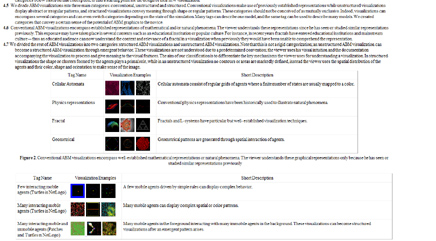Pretty interesting article just published in JASSS. If you happen to be involved in agent-based simulation design, you know how bad your model can be screwed up by poor visualization. Here are some guidelines you might find useful.
Visualizations are not only important for communicating your results to an audience (wether it is made of fellow-scientists or of lay-persons). It is also crucial to foster understanding of the phenomenon the model is actually describing. So it is all the more surprising to see how many modellers create ineffective visualizations of agent-based models (ABM). An example that comes from my field: Netlogo rendition of Axelrod’s Ethnocentrism, is basically a mess of similarly-shaped and almost indistinguishable “turtles” which would profit (and thanks to the authors of this article it does profit) from a revamping involving the use of intuitively different shapes. Not only the new visualization of the model is easier to read, but it also allows to detect the emergence of social phenomena of cooperation,strategy inheritance, etc.
Poor visualization is sometimes due to lack of experience with visual design. Some other times it is sheer lack of common sense. This paper provides both, and delivers them as a set of guidelines. The techniques used to structure these guidelines are based on semiology, scientific visualization (this is where experience comes in), and Gestalt psychology (this is what I call common sense :). The guidelines are illustrated using models taken from the NetLogo ABM library. It would be interesting to see the same suggestions applied also to other softwares – notably MASON or Swarm.
Kornhauser, Daniel and Wilensky, Uri and Rand, William (2009). Design Guidelines for Agent Based Model Visualization Journal of Artificial Societies and Social Simulation, 12 (2)
